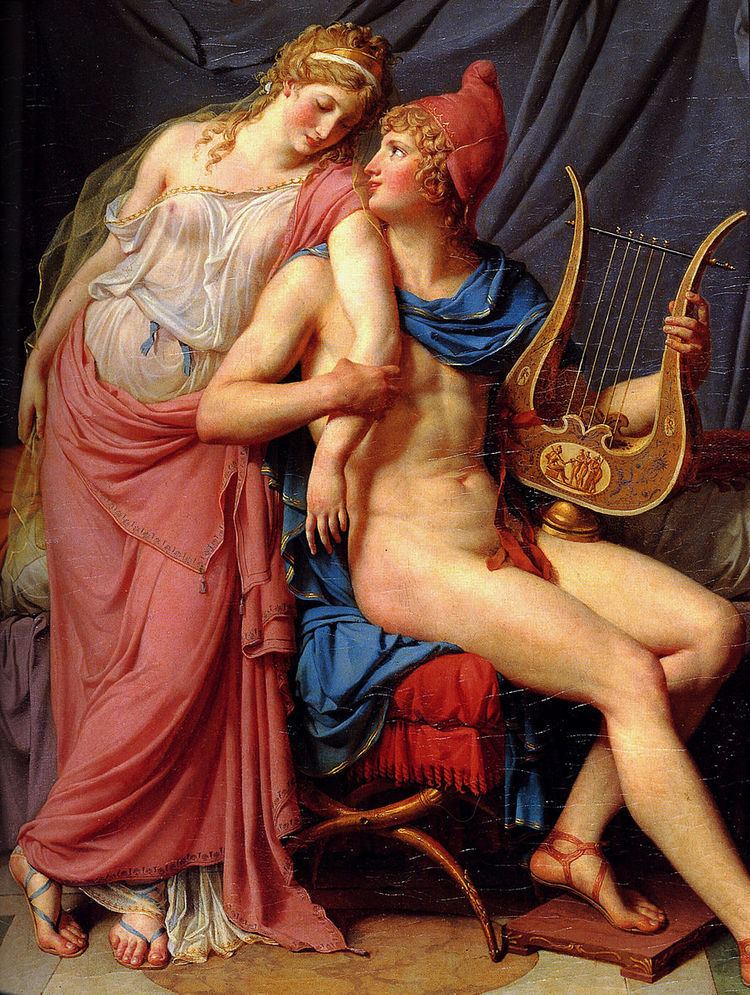 | ||
Similar Sappho books, Other books | ||
Sappho 16 is a fragment of a poem by the archaic Greek lyric poet Sappho. It is from Book I of the Alexandrian edition of Sappho's poetry, and is known from a second-century papyrus discovered at Oxyrhynchus in Egypt. Sappho 16 is a love poem – the genre for which Sappho was best known – which praises the beauty of the narrator's beloved, Anactoria, and expresses the speaker's desire for her now that she is absent. The poem is at least 20 lines long, though it is uncertain whether the poem ends at line 20 or continues for another stanza.
Contents
Preservation
Fragment 16 was preserved on Papyrus Oxyrhynchus 1231, a second-century manuscript of Book I of an edition of Sappho, published by Bernard Pyne Grenfell and Arthur Surridge Hunt in 1914. In 2014, a papyrus discovered by Simon Burris, Jeffrey Fish, and Dirk Obbink – P. GC. inv. 105 – added a few words to the known text of the poem. This papyrus dates to the late-second or early-third century, and is in the same hand as P. Sapph. Obbink, also published in 2014 and preserving five stanzas of Sappho's Brothers Poem.
Poem
Fragment 16 is, along with the other poems of Book I of Sappho's works, composed in Sapphic stanzas. At least five stanzas survive; whether the poem ends there or continues into what Burris, Fish, and Obbink number fragment 16a is disputed. The poem is one of five surviving poems by Sappho which is about "the power of love". It expresses the speaker's desire for the absent Anactoria, praising her beauty. This encomium follows the poet making the broader point that the most beautiful thing to any person is whatever they love the most; an argument that Sappho supports with the mythological example of Helen's love for Paris. Some commentators have argued that the poem deliberately adopts this position as a rejection of typical Greek male values. The poem follows a chiastic structure, beginning with a preamble, moving through to the mythical exemplum of the story of Paris and Helen, and returning to the subject of the preamble for the concluding stanza.
The poem begins with a priamel – a rhetorical structure where a list of alternatives are contrasted with a final, different idea. The first stanza opens with a list of things which some people believe are the most beautiful in the world: "some say an army of horsemen, others say foot soldiers, still others say a fleet". The poet goes on to propose a more general rule: that in fact superlative beauty is a property of "whatever one loves".
This introductory stanza is followed by a mythological exemplum to demonstrate this idea – that of Helen of Troy, who abandoned her husband, daughter, and parents to be with the man she loved. This use of Helen as a mythological exemplum might be seen as problematic: after all, Helen is the most beautiful mortal, and yet Sappho has her judging Paris to be the most beautiful. Harold Zellner explains this apparent paradox as an integral part of the argument that Sappho makes that the most beautiful is the one that one loves: the apparent contradiction between Helen being the most beautiful, and Helen finding Paris the most beautiful, can be resolved if we agree with Sappho's definition of beauty.
Many commentators have suggested that Sappho's use of Helen as an example in this poem is intended as a rejection of masculine in favour of feminine values. For instance, John J. Winkler argues that the poem sets Sappho's definition of beauty against a masculine ideal of military power. However, G. O. Hutchinson notes that, though the definition of beauty Sappho attacks might seem a characteristically male one, the definition she replaces it with is generally applicable, rather than being solely relevant to women.
After setting out Sappho's definition of what beauty is, the poem moves into a more personal section, recalling the narrator's beloved, Anactoria. The transition from the mythological example of Helen and Paris to the narrator's desire for Anactoria is missing, so it is not known what exactly reminded the narrator of her. George Koniaris believes that this transition, with the apparently spontaneous introduction of Anactoria, makes Sappho's praise for her seem fresh; by contrast, Hutchinson sees it as emphasising the deliberate artificiality of the work.
Continuation after line 20
Scholars disagree on whether fragment 16 continued after line 20 or ended at this point. Before the discovery of the Green Collection papyri, most scholars believed that the poem ended at line 20, and when Burris, Fish, and Obbink published the Green Collection papyri, they too ended the poem there. If the poem did end at this point, the priamel around which the poem is based is complete, and the poem would have had a ring structure. However, Joel Lidov argues that the stanza which Burris, Fish, and Obbink consider the first of fragment 16a fits better as the end of fragment 16. Rayor and Lardinois also believe that lines 21–24 of P. GC. inv. 105 are part of fragment 16, drawing comparisons with line 17 of fragment 31 and the ending of the Tithonus poem, two other cases where a poem by Sappho ends with the narrator reconciling herself to an impossible situation.
